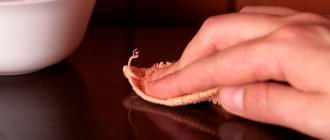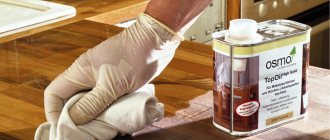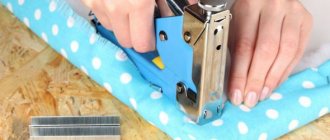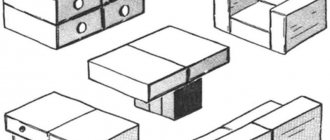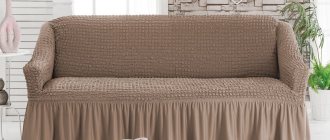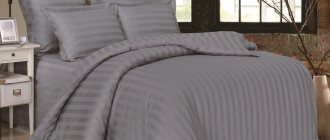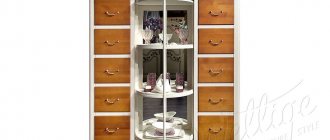Furniture coated with varnish will always look beautiful and respectable if it is properly cared for. After all, any dirt, the slightest dust and scratches are especially clearly visible on the smooth, shiny surface of a cabinet or trellis. There are many industrial products and folk methods that allow you to clean polished furniture and rid your favorite interior items of various contaminants. When choosing a cleaning composition, it is necessary to take into account that expensive polishes are not always more effective than conventional food substances (talc, flour, raw potatoes, vinegar or milk) that are used to preserve polish.
Types of stains on polished furniture
Polished furniture attracts dust more than any other. This can be explained very simply. A smooth surface, not treated with an antistatic agent, attracts dust particles and small specks, which are clearly visible on the mirror surface of the tabletop. The task becomes more complicated if there are small cracks or scratches on the surface of the table or cabinet doors: it is much more difficult to deal with dirt that has clogged up in microcracks than with dust on a flat surface.
In addition, the following types of contaminants are clearly visible on polishing:
- fingerprints;
- accidentally spilled liquid;
- paraffin, wax, plasticine;
- imprints left by a cup of hot tea or a heated frying pan.
In any case, you need to know how to clean polished furniture without risking harm to your favorite table or cabinet.
Safe chemicals and improvised means
The varnish coating is sensitive to abrasive cleaning agents, chemical solvents and mechanical stress. It is unacceptable to clean the polished wall or cabinet doors with a wire brush, acetone or gasoline. With such care, furniture polish will, at best, become dull, and at worst, it will crack, crumble and crumble.
Today, hardware stores offer a wide selection of specialized products for the care of polished furniture. The use of each of them gives a certain effect, which must be taken into account.
Here are some of the most popular products used to care for furniture with varnished surfaces:
- Wax-based polishes - Joy By Joy, Pronto, Chirton, Emsal.
- Compositions with a tinting effect - Pronto, 5+, Emsal.
- Products that create a protective layer are Diva, Mebelux, Luxus.
- Based on silicone - “Cinderella”, “Anti-dust”.
These tools are very easy to use. It is enough to apply a small amount of the composition on a dry cloth and polish the varnish surface to a shine.
Before starting cleaning, you need to test the product by treating a small area of the surface in an inconspicuous place.
To avoid damaging the varnish layer when removing stains, do not use hard metal brushes or scrapers. It is better to use cotton or flannel napkins, cotton pads, and soft brushes to remove dust. Sticky wax or plasticine can be removed with a wooden stick or spatula.
Applying varnish
Let's talk about which varnishes are best to use. The best are considered alkyd (Tikkurila Unika-super series), polyurethane and water-polymer (good ones are Swedish Bask).
Despite the lack of odor, water-based varnish is not the best choice for your first varnishing experience. Essentially it is a water-based suspension. But it is far from being as harmless as is commonly believed. Water-based varnishes contain very harmful solvents, albeit in small quantities. It’s just that the usual acetone and others cannot keep such a composition in a stable state. So we have to use much “cooler” solvents.
This is by the way, but the reason is essentially different - difficulties during processing. When applying varnish, water is absorbed into the wood fibers and they rise. As a result, after the first treatment, the surface is far from smooth, but very rough. This effect is especially pronounced on pine products. So after the first layer of water-based varnish has dried, take an angle grinder or a sander, attach 320-grit sandpaper to it and sand it until smooth. If you're lucky, the next layer will lie flat and the pile won't rise again; if not, you'll have to repeat the operation again. The situation is not fatal, of course, but unpleasant. This does not happen with other varnishes.
How to apply varnish
Now a little about how to apply varnish. Professionals believe that the best method is spraying from a spray gun. This may be true, but not all home craftsmen have such a device, and you also need to be able to work with a spray gun. Among manual application methods, a popular method is application with a piece of foam rubber (or a new kitchen sponge) or a fabric swab (soft, white, lint-free fabric). To decide, you need to try what is more convenient for you, how it turns out smoother (if it works out at all).
The next method is with a small foam roller. Suitable if you are varnishing a surface of a simple shape without small details (a door leaf, for example).
Applying varnish with a brush is the most unpopular method
The use of brushes when varnishing furniture, oddly enough, is in last place. The fact is that it is difficult to evenly apply a layer of varnish in this way. You need a good brush with soft, thick, natural bristles, which should not tangle under any circumstances.
Technology
Regardless of the chosen method of applying varnish, its layers should be thin and of uniform thickness. Take a little product onto a brush/sponge/roller/tampon and rub it over the surface as thoroughly as possible. Next time we dip it in varnish only after the “weapon” no longer leaves any traces. In this way we cover the entire surface and leave to dry.
Many coats of varnish may be required
The applied layer of varnish does not dry completely, but the time indicated on the packaging of the varnish in the column “tack-free” or “application of the next layer”. On average, for water-based varnishes it is 1 hour, for alkyd varnishes - 5 hours. The next layer is applied using the same technique. The total number of layers is usually from 5 to 9, depending on the quality of the veneer and preliminary sanding. When the surface becomes absolutely smooth, the varnish is dried until completely dry - 2-3 days. After this, sanding begins again.
Traditional methods of cleaning lacquered furniture
In addition to expensive chemical polishes, which often have a very strong odor and are poorly tolerated by people with allergies, you can use folk remedies to clean furniture at home. Few people know that it is possible to renew the varnished surface of a table or bedside table, remove stains left by hot objects, or wipe off droplets of wax and glue with the help of flour, table vinegar, soap, milk and other products that are always found in the household.
Fresh spots
Oily finger stains stand out especially strongly on shiny surfaces. Furniture covered with such prints looks sloppy. There are several techniques to quickly get rid of traces of grease on polishing:
- A piece of laundry soap is soaked in water and the surface of the furniture is wiped with a soft cloth soaked in a soap solution.
- Grease stains are lightly sprinkled with flour, talcum powder or baby powder. Wait 10–15 minutes until the bulk product absorbs the fat, then wipe with a soft, clean cloth.
- Rub the contaminated surface with a potato tuber cut in half. 15 minutes after treatment, polish the table with a cotton cloth.
- Mix alcohol and vegetable oil, taking equal amounts of ingredients, and rub the furniture with this mixture.
- You can wash lacquered furniture with milk. Soak a napkin in milk, wring it out and wipe the area of contamination. Remaining liquid is removed with a dry cloth.
Whatever cleaning product is used, the job should always be completed by polishing to a high shine using a soft flannel.
Old pollution
To remove old stains, you will have to use more aggressive products with salt and acid.
- Using table salt you can remove marks left by hot dishes. To do this, wrap a handful of salt in a handkerchief, moisten the bag in vegetable oil and rub the damaged surface.
- Old stains are removed with 9% vinegar. If you leave acid on a furniture surface for a long time, the varnish may crack, so you need to act as quickly as possible, and after cleaning, carefully remove any remaining vinegar with a dry cloth.
- To clean the polish, tea leaves are useful. After drinking tea, put it in a cloth and wipe the furniture.
- Sauerkraut brine is a great way to remove dirty stains from polish.
How to wipe polished furniture for shine?
In order for your favorite furniture to last as long as possible and always please the eye with a clean, sparkling surface, it must be regularly wiped with special polishes or popularly known means.
- Burdock oil is excellent for finishing varnished surfaces. This inexpensive product is sold in pharmacies. It is better to purchase a composition without additional fragrances. The method of use is very simple: apply a little burdock oil to a gauze or cotton napkin and rub it over the varnish surface.
- The shine of polished furniture will be given by treating with vegetable oil mixed in equal proportions with table vinegar.
- Beer will help keep polished furniture clean and shiny. The drink (1 glass) is poured into a saucepan, a piece of paraffin candle is placed there and heated until the wax melts. The composition is cooled and applied to the cabinet doors or table surface. Remaining liquid is removed with a dry cloth.
Any action, regardless of the type of cleaning composition, should end with a thorough polishing with flannel or suede.
It is difficult to prevent dust and dirt from getting on polished furniture. However, if you carry out simple maintenance in a timely manner, which consists primarily of removing dust and antistatic treatment of the varnish surface, you will be able to enjoy the look of a stylish and presentable interior for many years.
Polished furniture is not the most popular type of furniture in modern houses and apartments. Such furniture looks luxurious, but you need to take care of it carefully and constantly. Polishing tends to get dirty, and people today don’t have so much free time and money to regularly care for such furniture.
In addition, polished furniture requires certain operating conditions. For example, it should not be placed near radiators or fireplaces; the heat can melt the polish and cause it to smudge. It is not recommended to place such furniture near windows during the cold season, as this can cause cracks to appear on the polished surface.
But since you have decided to purchase such furniture or you already have it, and you are faced with the constant appearance of stains, there are many ways to care for polished furniture and remove difficult stains that have appeared on it at home.
What is polish used for?
Car plastic polish has a composition whose main component is silicone. It also contains moisturizers, wax, fluorine-containing polymers, and binders. Products are available for sale in the form of creams, pastes and aerosols. The latter option is considered more popular due to its relative simplicity and ease of use.
Important! Polishes are used primarily for the restoration of plastic. However, they also contain substances that provide antistatic properties, so dust does not settle on the plastic. And thanks to fragrances, polishes significantly refresh the interior of the car.
How to clean polished furniture
It is worth knowing not only what means to clean polished furniture, but also what tools to use. Your arsenal of household equipment should include:
- A soft rag, necessarily either flannel or cotton.
- Cotton swabs can be useful for removing a variety of stubborn stubborn stains.
- Pieces of soft leather help the polish stay in good condition after cleaning.
- A soft brush is useful for scrubbing tough, stubborn stains, but due to its softness it will not damage the polish or the wood surface.
- Containers for water and auxiliary products.
- A knife for removing serious stains. Be careful with this tool; the cleaning process may damage the wooden surface.
Having these products in your inventory, you can carry out competent and high-quality cleaning of polished furniture at any time.
How to clean polished furniture
On the household chemicals market you can find various products that allow you to clean polished furniture. But not all of them are so good. Therefore, using the simple laws of chemistry, so-called home remedies have been invented, on which pennies are spent, which can easily rid furniture of dirt of varying complexity:
- Beer.
- A special solution of antistatic agent and shampoo.
- Olive oil and wine vinegar.
- Burr oil.
- Tea brewing.
The imagination of an ordinary person can easily imagine these remedies, so many readers will be horrified, because these recipes can leave even more stains on the furniture and cause damage to the surface. In fact, this is far from the case. With these products, any contaminants are quickly removed. Let us analyze in detail the effect of each product on the polish.
In detail, this is a recipe based on regular beer with the addition of a piece of wax. Any beer made with malt from the nearest store will do for this. You can use regular white candles for decoration as wax, after removing the wick.
Boil the beer together with the wax so that the wax is completely dissolved and the alcohol, which is dangerous for the polished coating, is removed from the beer. Now that the solution is ready, you can polish the furniture with it. Dissolved wax will add shine to the polish and strengthen the coating, and malt particles will remove the maximum number of contaminants.
Removing stains
While the above products can easily deal with dust and minor stains, they are unlikely to be able to remove complex stains. What to do if you find a difficult wax or ink stain on your polish? For such cases, numerous folk remedies have also been invented.
Difficult spots
Complex stains of unknown origin are removed with a mixture of vegetable oil and flour. Simply sprinkle a thin layer of flour onto the stained area and then wipe off with a cotton swab soaked in vegetable oil.
Removing traces of hot dishes
Hot dishes: a kettle, a saucepan or a simple cup of boiling water are very dangerous for polishing; they can melt it and leave unsightly and difficult to remove marks. You can get rid of them by using salt and sunflower oil. To do this, you need to wrap the salt in some light cloth and make a small bag. Rub the damaged area with this bag, and then wipe it with vegetable oil. After this, do not forget to wipe the surface dry.
Wax drops
Candle wax is also a very dangerous enemy of polish. However, it can be easily removed with a knife and gasoline. The wax is very easy to remove if you heat it up; to do this, you need to heat the knife a little and pry the wax off with it. After removing the main wax mass, a speck will remain, which can be easily washed off with gasoline.
Ink stains
Beer and wax work very well on such stains. In this case, the beer cannot be boiled, since it is the small amount of alcohol contained in it that will remove the ink. Leave the beer on the stain for a while, but do not get carried away - the alcohol can damage the surface. After the stain has been removed, the surface must be wiped with wax.
Heavy soiling
Heated vinegar can deal with particularly heavy stains on the polish. It's best to take 9%. Warm the vinegar a little and soak a cotton swab in it. Rub the dirty surface; the intensity and duration of cleaning depends on how deep the stain is. After cleaning, the surface can be treated with regular wax to restore shine.
Pre-grinding
Polishing furniture is a long process and it begins with sanding. First, all cracks and other defects are covered with wood putty of a suitable color. After it has completely dried (the period is indicated on the label), sanding begins.
A sander is best for polishing wood or veneer. Tape or disk is a matter of taste and preference; it also depends on the complexity of the furniture shape. You will also need a set of sandpaper from coarse (80) to very fine (1200) grit.
In extreme cases, an angle grinder with a special attachment (disc and Velcro) may be suitable. But when working with it, it is difficult to achieve a really good result - there is no required mobility of the sanding platform, so the result of such wood polishing will not be above average.
What you might need to varnish furniture
We start sanding with 80 grit. We use it carefully, removing only large irregularities. Then we repeat the treatment with sandpaper at 120, then at 180 and 240. During the work, we must periodically remove dust and inspect the surface to identify unevenness and other defects. sometimes they are better identified by touch.
Then take water and 320 grit sandpaper. Wet the surface to be sanded and the sandpaper. We sand everything again, but this time with water. At this stage, you should get a good result - everything should be smooth. If everything is satisfactory, we move on; if not, we polish it for some more time.
How to Add Shine to Polished Furniture
It also happens that after cleaning or simply over time, polishing loses its shine. How, in this case, can you restore the shine of polished furniture without resorting to expensive and dangerous chemicals? There are several proven options.
The first and most popular option is wax. A piece of pure wax without impurities can not only restore the shine to the surface, but also get rid of minor scratches and damage. The main thing in this matter is not to get too carried away with rubbing, apply the wax in a thin layer, otherwise the surface will become matte and completely lose its shine.
Vinegar solution
The second option is also very simple - it is a mixture of vinegar and vegetable oil. Soak a soft, lint-free cloth with this mixture and rub the surface until shiny, then wipe with a dry cloth to remove any remaining product.
What is polishing
Polishing is a process of finely treating a surface, giving it shine. As a rule, the varnish layer is polished, but the procedure can also be performed on the paint or the material itself. The processing technique is close to grinding, but the fineness of the abrasive in this case is an order of magnitude higher.
There are different degrees of surface gloss. There are glossy finishes that are highly shiny and reflective to surrounding objects. Furniture finished in this way looks elegant, bright, and glares when exposed to light.
Matte surfaces do not reflect light, their shine is very soft. As a rule, matte types of varnish are used for modern furniture, but ancient samples were coated with a special composition (classic shellac), or the wood was simply impregnated with oil, followed by processing with cloth swabs.
Expert opinion
Kokovin Dmitry Vasilievich
Furniture restorer
There are different polishing techniques. The basic method is to apply a special polishing paste to the prepared surface and process it using a polishing wheel made of foam rubber, felt, felt and other materials.
Furniture care products
The easiest way to care for furniture coated with polish is to use special household chemicals. The availability and large selection of such products allows you to maintain the aesthetic appearance of polished surfaces without much effort and time.
Simply apply all these products to the surface to be treated and polish it to a shine.
Before using household chemicals, you should carefully read the instructions for use, because Not all such products can simultaneously clean and shine polish. Some preparations should be applied to an already cleaned surface.
TOP 5 polishes for car interior dashboard (rating)
| Polish name | Polishing type | Key Advantage | Price |
| Kangaroo Leather&Tire Wax | Glossy | Protects the surface from defects and returns the original color. | 395 rub. for 0.5 l |
| Politura Gloss | Matte | After treatment, it creates a protective layer and returns the coating to the appearance of newness. | 240 rub. for 0.5 l |
| Turtle WAX | Matte | Returns original shine to plastic, vinyl and rubber coatings | 358 rub. for 0.5 l |
| FILL Inn FL010 | Glossy | Gently cleans the surface and protects it from fading, scratching and dryness. | 210 rub. for 0.335 l |
| Lavr Ln1459-L | Matte | Water-repellent, antistatic, provides UV protection | 224 rub. for 0.1 2l |
Car shampoos for manual washing
At wholesale prices from the manufacturer
View catalog
Home methods
Caring for various polished furniture at home also includes various recipes used by housewives in those days when it was difficult to buy the necessary products.
That’s when these effective, inexpensive recipes for polishing furniture at home appeared:
- Slept tea is perfect as a cleaning agent for polishing. To do this, the wet used tea leaves are wrapped in a soft cloth and the dirt is rubbed with such a wet lump. Then the polished surface is brought to a shine using felt or flannel.
- You can also clean polished furniture at home with regular milk. A napkin is soaked in milk and then all the dirt is washed off. Finally, the polish is rubbed until shiny with a soft, dry cloth.
- A mixture of beer and wax specially prepared for this purpose will also help to polish the surface. To do this, you need to dissolve a wax briquette in hot beer and leave it until it hardens. This mixture is applied to the surface and, using a natural wool napkin, the furniture is brought to a shine.
TOP 5 matte polishes for car interior plastic (rating)
| Polish name | Polishing type | Key Advantage | Price |
| Politura Gloss | Matte | Removes surface defects and returns original newness | 240 rub. for 0.5 l |
| Turtle WAX | Matte | Adds a matte shine to all plastic, vinyl and rubber surfaces | 358 rub. for 0.5 l |
| Lavr Ln1459-L | Matte | Provides an antistatic and water-repellent effect, protects against the damaging effects of ultraviolet radiation | 224 rub. for 0.12 l |
| GOODYEAR GY000714 | Matte | Treatment with the composition protects against ultraviolet radiation. The product has an antistatic effect | 215 rub. for 0.4 l |
| FILL Inn FL077 | Matte | Gives plastic a new look and reliably protects against ultraviolet rays | 200 rub. for 0.4 l |
Important! Matte polish differs from glossy polish in that it removes bright shine and reflections from surfaces, while removing various plastic defects. Glossy polish, on the contrary, forms a shiny film on the surface, which is slightly slippery. Due to the presence of silicone components in the composition, such products effectively eliminate existing scratches and protect against the appearance of new abrasions later.
Removing stains
How to clean stains that appear on a surface coated with polish?
The following traditional methods are suitable for this:
- Adhered dirt is removed with soap. Lather a soft damp cloth and quickly wipe the contaminated surface. After this, the polishing should be wiped well with a clean felt rag.
- To clean the surface of old fingerprints, you can use raw potatoes. To do this, the potatoes are cut in half, and hand marks are processed with the cut. Then the treatment area is thoroughly rubbed with a dry cloth.
- In difficult cases, any vegetable oil will help. Soak a cotton swab in it so that the oil does not flow or drip, and wipe the stains until they are completely removed. Then the remaining fat is blotted with a paper towel, and the surface is polished with a dry cloth.
- How to remove stains left by hot objects? Fine salt is tied into a knot of thin cloth and dipped in vegetable oil. Rubbing whitish hot spots with such a knot restores the appearance of the polish.
Polishing is resistant to alcohol and solvents. Therefore, you cannot not only treat the surface with these products, but also spill them on the polish.
Primer
It is necessary to prime wooden and veneered surfaces so that the varnish lays more evenly. When sanding, we opened most of the pores and released some of the fibers. If you immediately coat them with varnish, it will be absorbed unevenly, causing the surface to become stained. The primer closes most of the pores, so the varnish will lay more evenly.
Priming veneered furniture can be done in two ways. The first is quick, but accompanied by a strong odor. You need to take nitro varnish or polyurethane varnish, dilute it by 10-20% (depending on the initial thickness), and cover the surface.
A primer is necessary so that the varnish goes on more evenly.
The second method of priming is long, but correct and almost odorless. We take epoxy glue and a soft cloth swab. It’s better to use flannel, preferably white, so that it doesn’t fade or change the color of the furniture. Use this swab to rub the epoxy into the veneer.
While everything is drying, dust will definitely stick to the surface. It needs to be removed. This again can be done in two ways: scraping and grinding. If using a scraper, take a sharp blade (you can use a wallpaper knife) and use it to clean off all the excess. To avoid damaging the veneer, move the blade along the grain. With sanding everything is known: sandpaper with 320 grit and water. The prepared surface is cleaned of dust, washed with water, and dried. After drying, you can apply varnish.
In fact, further polishing of the furniture may not be necessary. Already at this stage the product looks decent.
Adviсe
In order for polished furniture to retain its aesthetic appearance for a long time, it must be properly cared for.
The operating rules are very simple:
- Polishing is afraid of high temperatures. Therefore, do not place hot objects on the surface of the furniture.
- Heating household appliances should be located at a safe distance from polished furniture.
- If the room is heated with a “warm floors” system, it is better to raise the furnishings on low legs. This technique will preserve the polish, make cleaning easier, and also eliminate the place for dust and dirt to accumulate, in which dust mites quickly grow.
- In rooms facing south, arrange furniture so that direct sunlight does not fall on the polish.
- Like any other piece of furniture containing wood fibers, polished furniture is susceptible to high humidity.
- To preserve the polish from scratches, cleaning cloths for polished furniture should be made of a material with a soft texture. Dust is removed from large inlay parts using a soft broom.
- Wipe off dust from the polished surface regularly to prevent dirt from accumulating on the polish.
- Do not use alcohol-containing solutions, acetone or other solvents to clean contaminants.
Furnishings covered with varnish will give the room a special chic and splendor. To preserve these qualities for as long as possible, you need to treat polished surfaces with care and regularly care for them.
Conclusion
Plastic is a fairly soft and pliable material that requires careful and regular care, even more than metal car parts.
Over time, plastic parts inevitably fade and become more fragile due to abrasion and exposure to ultraviolet radiation. However, you can restore the original attractive appearance of plastic using a high-quality polish.
Auto stores offer a great variety of different auto cosmetics of this nature, but it is important to purchase only the best for your car. Our rating presents the highest quality options for such products, the effectiveness of which is confirmed by numerous reviews from real customers.
